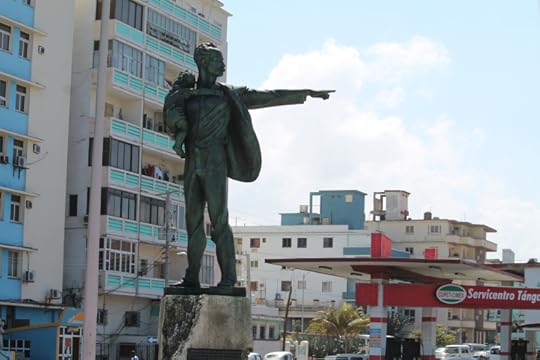Deborah Hining's Blog, page 2
February 29, 2016
Feasting in Cuba, day 4
Literature, friendship, shopping, more eating and drinking, and . . . Jesus!
Another big day had been planned for us here on our last day in Havana. Our tour directors were amazing. As soon as one thing fell through on our itinerary, they jumped on it and found a substitute. Every minute was filled and we had no idea how much time, effort, and their own money they expended to keep everything running smoothly. Here is a big shout-out to our hosts, Roberto Copa Matos and Elizabeth Turnbull of Old Havana in Durham, NC, and to Leyte and Saul Rivera of Leyte Global Services. If I have not made it clear that you should not attempt to do Cuba alone, let me reiterate: This country is not a DIY destination. You need somebody who knows the ropes to tiptoe through the myriad knots that will trip you up. Since both Roberto and Leyte have the advantage of being Cuban, their knowledge came in extra handy.
We started the day visiting Libro Café, an independent bookstore/lending library owned by Connor Gorry, an American ex-pat and journalist who loves Cuba and is trying to improve the life of the people in her community. Anyone can come to her place to read all he wants without regard to funds, and the place was crowded with young people who come here to read, snack, and visit with each other. Of course, there are plenty of public libraries in Cuba, but the types of books available there are limited. Independent bookstores and libraries have not enjoyed much freedom in the past, with librarians being subjected to prison sentences for offering “unacceptable” books, but constraints are slowly relaxing. As Cubans have greater access to the internet, no doubt restriction on thought and speech will begin to disappear.
One of the most frustrating things about being in Cuba was the lack of internet. Although some access is available at the hotels, many times service was down. Every time I tried to buy a card so I could check in with my family, I heard, “Sorry, no service right now. Check back in an hour” or “a day.” Connor hopes to offer free internet to her clientele one of these days, but she, like everyone else, is facing the excruciatingly slow pace of change.
Our time at the Libro Café was well spent. She had invited three young Cubans came to chat with us. One was a medical doctor who has switched careers to become a chef and tattoo artist. We thought this was odd. Why would anyone go through the rigors of medical school and then just give it up to work in food and ink? Her reason was rather sad: She wanted to become a urologist, but because the government wants more GPs and fewer specialists, she could not continue her training, so she turned her back on medicine altogether. I also suspect some other thoughts may be brewing in the minds of many highly educated Cubans to cause them to rethink their careers:
Going to school in Cuba is not only free, it’s relatively easy because the government gives everyone a stipend while they are studying. It isn’t much of one—worse than starvation wages, actually, but so are the wages of American, who also are burdened with tuition costs. If you love to learn and don’t mind holding down a job while you are working, taking advantage of the free educational system in Cuba could be the way to go. It doesn’t matter if you don’t stay in the profession. You don’t have a mountain of student debt to clear once you graduate.
As I discussed earlier, since professions with high prestige pay less than those of lower prestige, no professional in Cuba earns a living wage (I’m sure there are exceptions for those who have friends in high places). Since you aren’t financially tied to your professional path, there is no reason to stay with it if you decide you like something else better. As far as I can tell, the only reason to be a doctor in Cuba is if you love medicine. You certainly don’t do it for the money. If you happen to love being an artist and can earn a more lucrative income by practicing your art in the private sector, then why not go for it?
I know this seems strange to anyone who has grown up in a capitalistic society where education tends to be the means to an end. In Cuba, you can get an education just because you feel like it. Oddly, the Cubans I met seem to appreciate their education more than Americans do, and they take it more seriously in some ways. Granted, we met some stellar young people who perhaps were the best examples of the society, but I have to say, these kids were extraordinarily bright, sophisticated, well educated, and well rounded–Renaissance men and women, with interests in many disciplines. They knew more about American politics than the above-average American university student does. They understand the ideologies of all our potential presidential candidates and the implications of what it means to Cuba and the world if any particular one of them is elected. It was very impressive, how hard they work, how much they know, how enthusiastic they are, how committed they were to making the world a better place.
At the request of Connor, we had brought books to donate to the library. Although I thought it was a little silly to bring romance comedies about hillbillies to a bookstore in Havana, my publisher insisted on bringing my two novels to contribute. Here I am with a copy of A Sinner in Paradise and an advance review copy of A Saint in Graceland, which at this very minute may be being read by a Cuban thirsty to know what life in West Virginia is like. It boggles the mind to think about it. My books in Cuba!

Hey Mom, Look! My books are being read in Cuba!
At lunch, I managed to make my way through yet another serving of pork while cursing my allergy to seafood and fish. I also was beginning to find it difficult to look at black beans and rice. Images of pizza, chef salads, and guacamole began to swim in my head. But the mojitos helped to quiet those longings. After two, I did not mind another round of beans and rice, although I pushed aside the yucca.
Then we were off to the street market to find souvenirs and meet a slew of artists taking advantage of one of the few areas of free enterprise. Being an artist, Roberto knows several of the vendors of contemporary art being offered there, so he spent a convivial hour or two reminiscing with his old friends about the art scene in Havana. It was a great experience, and several of our group found some wonderful things. Aside from the fine art, the market offered a plethora of fun gadgets, like wooden replicas of classic cars, toys made from coke cans, items of clothing, and all the other kinds of things you see at American flea markets, including things made in China, but might be enticing to a tourist eager to buy.
Of course, Mike got thirsty after just a few minutes at the market, so we made our way to the next block where we found a bar while we waited for everyone to finish making their purchases.
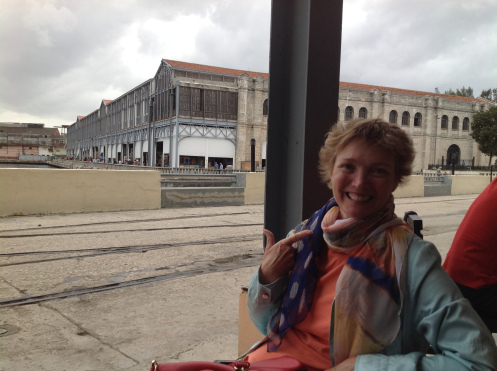
At the bar on the waterfront, waiting for the others. The market is the long white building behind me. The scarf was my only purchase because I was tired of being cold
After that, we went to the newly opened US embassy, guarded by Cuban guards, and made another tour through a different part of Havana. The streets in the newer part of the city are very long and straight, and very beautiful. I can see why Cuba was once known as the “Pearl of the Caribbean.” Obviously, this was once a thriving place, rich in money, imagination, creativity, and skill. The architecture is so much more whimsical, colorful, graceful, and ornate than anything I have seen in the United States.
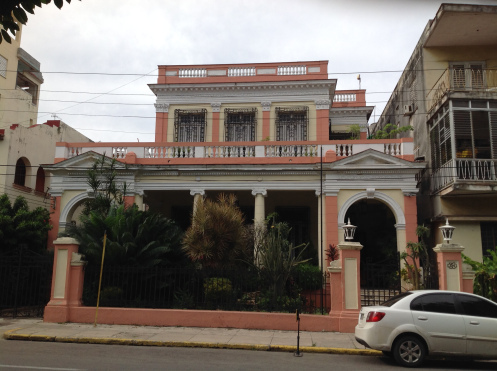
Typical beautiful house built before the Revolution.
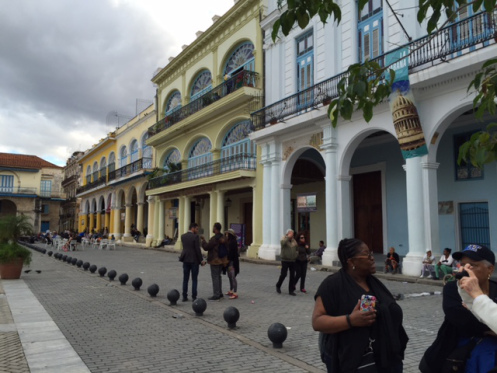
The Old Square. The Big Chicken you saw in the first post is behind me
One of the prettiest places in Havana is their Central Park, where the Capitol building resides. Built in 1929, it is a copy of the US capitol, but with a twist: it is 12 inches taller than ours is.(“Ha, ha, take that USA!”) Next door to that is the Opera house, a grand theatre built in 1837 and now houses the National Ballet Company.

The slightly taller Capitol building and the beautiful Opera House. The little cars in the foreground are typical transportation if you don’t want to ride in a classic car.
Then it was back to the old town in Central Havana. We spent the waning afternoon strolling through very old, dilapidated, pothole-infested streets, grieving for the slow deaths of the lovely buildings. Up until now, we had not seen any beggars. Today we saw only two, and they were not particularly good at the craft. You could tell they were just beginning to realize that they could ask for handouts from tourists, but had not yet figured out how to do it well. One woman yelled at us, “Hey, give some money to my baby,” as she waved toward one very well-fed, well-dressed, embarrassed looking boy. Another man approached us, speaking very rapidly in Spanish, motioning us to follow him, but we could not make out what he wanted. He also looked awfully energetic and well-dressed to be a beggar.
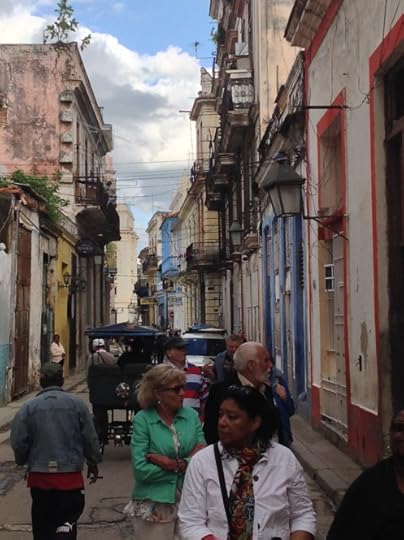
Dinner at the Paladar Dona Eutimia was good, but by now I am getting sick of chicken as I listen to everyone else raving about their fish. I will scream if I eat one more bite of black beans and rice or even look at another piece of boiled yucca. Dessert made up for the predictable food, however, as did the frozen mojitos. I thought the mojitos were good yesterday, but if you’ve never had a frozen mojito before, you haven’t lived. Dessert was special because we were celebrating the birthday of the lovely Deidre, whose name fits her perfectly.
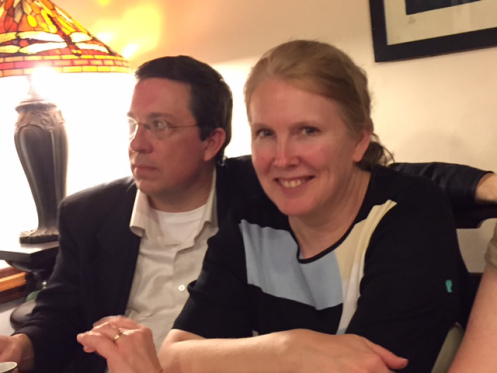
The Birthday Girl and her Sweetie
At the end of dinner, we piled back onto the bus for the short ride back to the hotel.
Driving along the Malecon, (the boulevard bordered by the seawall) we caught a glimpse of an enormous statue of Jesus all lit up, standing on the hill. It was surprising—and nice—to see it. I never expected such an obvious icon of Christianity in this country. Although religious tolerance is rapidly gaining ground in Cuba, and they are far from the days of dragging Christians before the firing squads, the government still favors atheism. The statue has been standing there, unmolested since 1953. Thank you, Castro, for allowing art to survive, even if it goes against your religious and political inclinations.
There are, in fact, many statues throughout Cuba, with a long tradition of sculpture embedded in the culture. Every important event is marked with a statue or several. Near the old marketplace, at the “Anti-Imperialist” Plaza, stands an imposing statue of a man holding a child. At first, I thought it a touching reminder of how Cubans love their children—I had seen nothing but obvious devotion of Cubans and their offspring. But later, I discovered that it was a representation of the Elian affair, when the Cuban child, Elian, who was kidnapped by his mother from his father who had legal custody, back in 1999. She made a run for Miami in a boat that capsized, drowning all but the child, who somehow made it to the United States, supposedly with the help of dolphins. After a long court battle, Elian was literally dragged from his aunt and uncle’s home in Miami by police and reunited with his father in Cuba. I remember the incident, and at the time, I felt sorry for the poor child who would not be allowed to live in freedom after all his mother had sacrificed for him. But the Cubans have a different take on the story. The man in the statue, Cuban hero Jose Marti, holds Elian tightly, protectively, as he points an accusing finger toward the United States. Clearly, the Cubans see the incident as yet another attempt of the Imperialists to infringe on the rights of even the most vulnerable Cuban citizens.
It was another good day in Cuba. Although I am missing my family and wishing I could communicate with my babies, I am still happy to be here.


February 25, 2016
Feasting in Cuba, Day 3
Farm, Food, Art, and Musical Theatre
This is the third installment of our adventure in Cuba. If you want to begin at the beginning, go to my post on February 19, 2016
After our usual fantastic breakfast in the Hotel buffet dining room, we headed out to the country to visit a farm. The weather was clear and cool. By now, I was wishing I had brought warmer clothes, but I was grateful for the one sweater and one rain jacket I did pack at the last minute.
The farm we visited was called La Mora, which has two meanings: it can be translated roughly as “beautiful black/brown woman,” or more correctly, it is a fruit grown all over Cuba. The African American women in the group chose to think of it as the former.
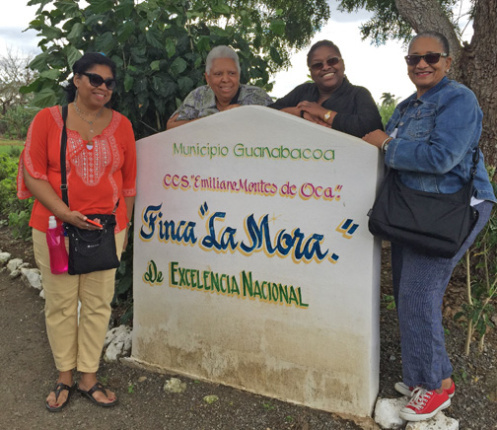
The feisty and fun Las Moras
Gualberto, the man who owns and farms La Mora took time out of his busy day to give us a complete tour of the inner workings of his enviable farm.

I don’t know which I liked better. The farm or the farmer
I have a thing for beautiful dirt. Our dirt at Corinne’s Orchard is better suited for making bricks than it is for growing things, and we have spent incalculable time and money trying, unsuccessfully, to turn it into good, black soil. Piedmont clay eats organic material and just grows heavier, stickier and redder the more you feed it. Today I have learned that one of the nicest things about Cuba is its dirt, and I say that with complete sincerity and admiration.

Nice dirt, huh?
I also admired Gualberto’s skill, his work ethic, his knowledge, and his resourcefulness. He plants two or three crops together so one can grow up in the shade of the other, or one will come to maturity after the first has been harvested. Cuban farms are small, and government demands mean that the farmers have to make full use of every square inch of growable dirt. All the hard work shows. I marveled at the paucity of weeds, the organic insect traps made of bottles and molasses, the careful composting. Gualberto and I developed a crush on each other. I weeded his peas (I couldn’t help myself, the dirt was so pretty and loose, and the weeds were so easy to pull) and he called me a “doll.” It’s obvious those Cuban farmers love a woman who likes to get her hands dirty.

I couldn’t help myself. Those weeds were begging to be pulled

The worm bin. Boy, was that good compost! See all the bananas growing in the background?
At the farm, Roberto bought lots of vegetables to add to the dinner he planned to make for us in a couple of days, we were treated to a demonstration on how to harvest worm castings (best fertilizer ever), and then we slurped down coconut milk and ate tamarind right off the tree, before we headed out for lunch at Mediterraneo, the privately-owned Havana restaurant which buys its produce from La Mora. Farm to table in action, and the food was absolutely fresh and well prepared. I had suckling pig, Mike had the red snapper, and everyone who had the fish raved about it, saying it was fresh simple, and delicious. My pork was quite good as well, but I think the best thing was the mojitos. I’ve never tasted anything better.
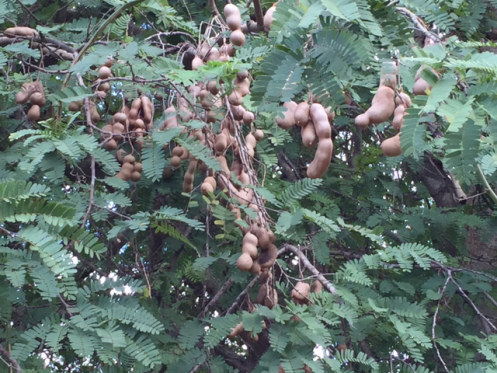
Tamarind

Mojitos!
After lunch, we met with yet another artist who gave us a tour of some galleries. Cuban art is secretly didactic, and as such, I could not understand much of it until it was explained to me. Once I made the connection between the art and the politics, I came to appreciate it very much. Here is a picture of Mike in an interactive exhibition, which comments on the commercialization of art. I think it’s cute, and certainly would have no problems taking it home with me!
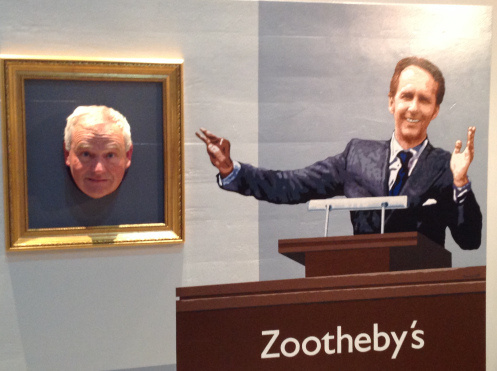
Sold to the lady in the red hat!

What political commentary does this make?
We ate dinner at the fancy restaurant at the hotel, but since I was still stuffed from our excellent lunch, all I had was soup. Mike seemed to have room for another round of fish, complete with dessert and brandy. We had to rush because we had an evening planned at a cabaret show in a theatre that was built for and by the Mafia folks in the 30s, in the grand old style. The show also was patterned after the grand old style as well, with lavish costumes, lots of singing and showstopping dancing, and a storyline that did not make a whole lot of sense. I would like to say we stayed out until midnight, enjoying the show all the way to the grand finale, but I was nodding off by 10 pm, so I was glad when Mike suggested an early exit and we crawled off to bed.


Feasting in Feasting in Cuba, Day 3
Farm, Food, Art, and Musical Theatre
After our usual fantastic breakfast in the Hotel buffet dining room, we headed out to the country to visit a farm. The weather was clear and cool. By now, I was wishing I had brought warmer clothes, but I was grateful for the one sweater and one rain jacket I did pack at the last minute.
The farm we visited was called La Mora, which has two meanings: it can be translated roughly as “beautiful black/brown woman,” or more correctly, it is a fruit grown all over Cuba. The African American women in the group chose to think of it as the former.

The feisty and fun Las Moras
Gualberto, the man who owns and farms La Mora took time out of his busy day to give us a complete tour of the inner workings of his enviable farm.

I don’t know which I liked better. The farm or the farmer
I have a thing for beautiful dirt. Our dirt at Corinne’s Orchard is better suited for making bricks than it is for growing things, and we have spent incalculable time and money trying, unsuccessfully, to turn it into good, black soil. Piedmont clay eats organic material and just grows heavier, stickier and redder the more you feed it. Today I have learned that one of the nicest things about Cuba is its dirt, and I say that with complete sincerity and admiration.

Nice dirt, huh?
I also admired Gualberto’s skill, his work ethic, his knowledge, and his resourcefulness. He plants two or three crops together so one can grow up in the shade of the other, or one will come to maturity after the first has been harvested. Cuban farms are small, and government demands mean that the farmers have to make full use of every square inch of growable dirt. All the hard work shows. I marveled at the paucity of weeds, the organic insect traps made of bottles and molasses, the careful composting. Gualberto and I developed a crush on each other. I weeded his peas (I couldn’t help myself, the dirt was so pretty and loose, and the weeds were so easy to pull) and he called me a “doll.” It’s obvious those Cuban farmers love a woman who likes to get her hands dirty.

I couldn’t help myself. Those weeds were begging to be pulled

The worm bin. Boy, was that good compost! See all the bananas growing in the background?
At the farm, Roberto bought lots of vegetables to add to the dinner he planned to make for us in a couple of days, we were treated to a demonstration on how to harvest worm castings (best fertilizer ever), and then we slurped down coconut milk and ate tamarind right off the tree, before we headed out for lunch at Mediterraneo, the privately-owned Havana restaurant which buys its produce from La Mora. Farm to table in action, and the food was absolutely fresh and well prepared. I had suckling pig, Mike had the red snapper. However, the best thing was the mojitos. I’ve never tasted anything better.

Tamarind

Mojitos!
After lunch, we met with yet another artist who gave us a tour of some galleries. Cuban art is secretly didactic, and as such, I could not understand much of it until it was explained to me. Once I made the connection between the art and the politics, I came to appreciate it very much. Here is a picture of Mike in an interactive exhibition, which comments on the commercialization of art. I think it’s cute, and certainly would have no problems taking it home with me!

Sold to the lady in the red hat!

What political commentary does this make?
We ate dinner at the fancy restaurant at the hotel, but since I was still stuffed from our excellent lunch, all I had was soup. Mike seemed to have room for another round of fish, complete with dessert and brandy. We had to rush because we had an evening planned at a cabaret show in a theatre that was built for and by the Mafia folks in the 30s, in the grand old style. The show also was patterned after the grand old style as well, with lavish costumes, lots of singing and showstopping dancing, and a storyline that did not make a whole lot of sense. I would like to say we stayed out until midnight, enjoying the show all the way to the grand finale, but I was nodding off by 10 pm, so I was glad when Mike suggested an early exit and we crawled off to bed.


Feasting in Cuba, Day 2
Feasting in Cuba, day 2–Religion, Art and Architecture
This is part two of my account of our trip through Cuba in early February, 2016.
Part one was posted February 19
Our fabulous tour leaders had planned a full day for us, so we woke early and went to the hotel buffet dining room for breakfast, which was excellent. The eggs were fresh and delicious, which is saying a lot for me, because my eggs at home are always fresh and delicious. Some days I take the eggs right out from under the hens for my breakfast omelet, so you know these Cuban eggs must have been something special.
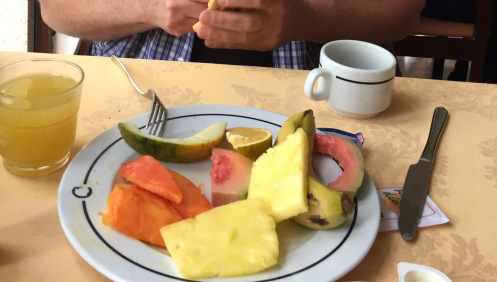
Breakfast dessert
Because we were not “tourists,” but part of a sanctioned “People-to-people” group with certain obligations, we had a packed itinerary scheduled for our first full day on this wonderful island. Fortunately, we had excellent planners who worked hard to make our days interesting, and they had found knowledgeable local guides to give us a running commentary as we visited the sights. Mary, our guide for the day obviously was proud of the Cuban education and medical systems, and she happily recounted all the benefits of living under Fidel Castro’s benevolent leadership. The educational system is excellent. All children are required to attend school until age 15, and then anyone can go on to the university or to any type of school they wish, for free, including medical school or law school. The medical care also is excellent and free, or costs a very nominal fee (a dollar or two for prescription meds).
Mary did not discuss any of the downsides of Castro’s benevolent leadership. We got that later from other Cubans, who informed us that while medical care is, indeed, free, and of good quality, drugs and equipment are in very short supply. Doctors are forced to diagnose diseases without much in the way of MRI machines, X-ray machines, and in some cases, even blood pressure cuffs. All basic drugs, including aspirin are dispensed by prescription only, but good luck getting any. The sad truth is that the US is partly responsible for the lack of supplies. Our embargo has done its damage, not to the powers of the Socialist government, but to the people. Lifting the embargo will not make Castro’s life any easier—he already gets everything he needs—but it will make life easier for millions of Cuban people and will save and extend the life of many. Something as simple as a few X-ray machines will make an enormous difference.
I’d like to take a minute here to discuss the situation for medical doctors and other professionals in Cuba. Castro’s brand of Socialism ushered in an upside down economic pyramid. Nearly everyone, from truck drivers to farmers to college professors and doctors work for the government, and the professions with the most prestige earn the least amount of money, while the laborers, particularly the farmers, earn the most. Our tour bus driver earns about $1.50 per day, plus tips, which, judging from the generosity of the people in our group, can be quiet substantial. Doctors earn a whopping $1 per day.
You read that right. One. Dollar. Per. Day. You may well ask how anyone can survive on that kind of salary.
The short answer is: they can’t. Until the collapse of the Soviet Union, everyone got food ration tickets courtesy of the Kremlin, and as long as they kept the funds coming, the Cuban people were able to exist, albeit on a limited diet. However, after the Russians stopped sending aid in 1991, during the “Special time,” the situation got terrible. People literally starved, and nearly everyone was forced to find a second job, many in the tourist industry, many in the black market. Farmers slipped out a little extra something here and there so they could have a little nest egg. College professors drove taxis or tended bar in the evenings. When our host, Roberto, lived in Cuba, he supported himself by selling his paintings to tourists at the Havana market, earning far more than his regular job as a biochemist in a laboratory paid. I was astonished to discover that the beautiful hand embroidered dresses that I bought in a street market for my granddaughters had been made by a practicing medical doctor.
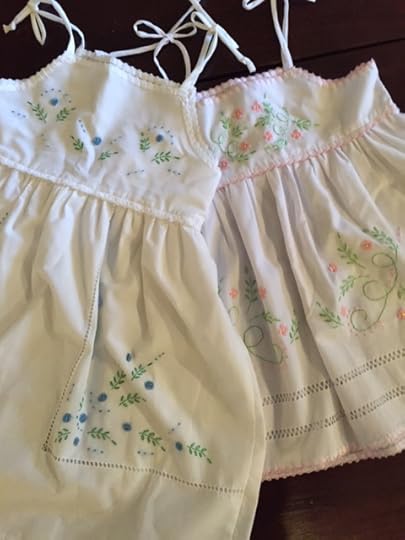
Things are getting better as the government is beginning to allow some free enterprise, and the people are discovering that a good way out of poverty is to start a business. Restrictions are still very tight, however, and it is evident that Cuba has a long way to go before it can be considered a land of plenty.
On our trip out from our hotel this day, we got our first lesson in Cuban bureaucratic sloppiness, or maybe greed. Our hosts had made arrangements months in advance for us to see Hemmingway’s estate a few miles outside of Havana. They had paid the admission for all 18 of us, and had verified that we would be arriving on February 7, 2016. We rode the considerable distance to get there, only to discover that it was closed for “maintenance.” Welcome to Cuba! On our first full day, we learned the reason why Cuban guides are always saying, “I hope you have a good visit without too many problems.” They know their country well.
All tours and accommodations are arranged by the government tourism agency (no free enterprise here), and the people who run it are not overly anxious about making a good impression or even about keeping promises. If some bureaucrat decides to close an attraction, it does not matter that people have paid to see that attraction. You just have to get over it. They will promise to make it up to you—we could go to see Hemmingway’s place in a week or two (after we had left the country), and if we did not choose to take advantage of the later date, then, they are sorry but they cannot refund any money after we have refused their generous offer.
We were not terribly disappointed at not seeing the Hemmingway estate, for by now we had learned to roll with the minor upsets that make their regular appearance in Cuba. As an alternate activity, we took a tour of Havana in vintage cars. Our ride was a beautiful purple and white 1956 Buick convertible. The ragtop was tattered, the radio and windows were missing, the suspension was loose, much of the interior was rusted, but she was spacious and glorious, and she moved like an elegant dancer floating down the pothole-ridden street. We had to keep the top up for the first part of the trip due to the rain, but later, the sun came out and we got the glory of driving around Havana in free-air style.
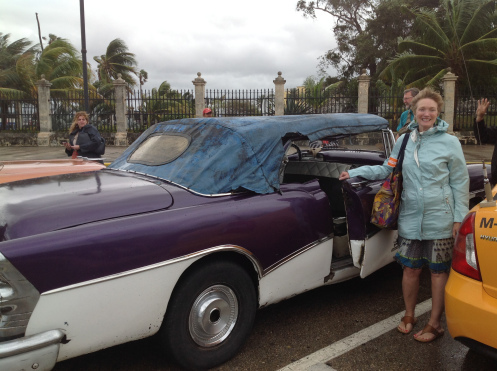
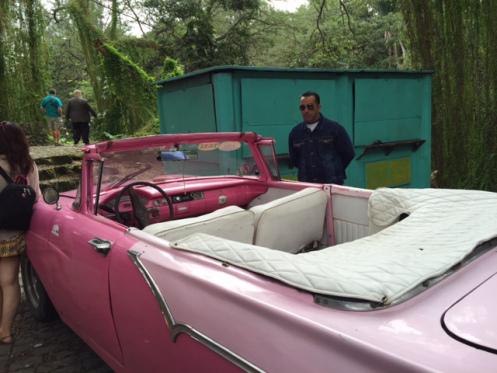
Our Buick took us first to Revolution Square, a huge area dominated by a 358-foot tall tower that is vaguely reminiscent of the architecture of the Third Reich. There are statues and pictures of Revolution leaders around the square, as well as housing for government agencies. This is the place for political rallies and where Fidel Castro gave his famously long speeches (one lasted over 7 hours) to the millions of Cubans who gather in the square to celebrate important Revolution anniversaries.
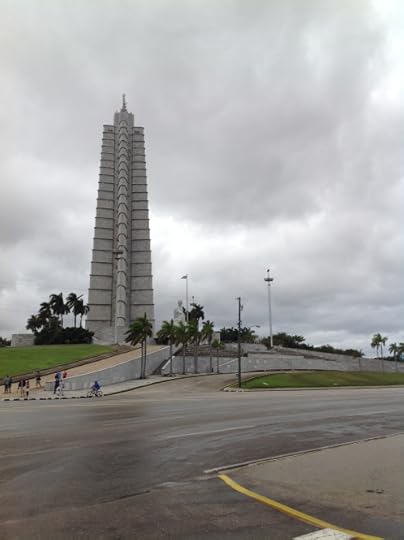
After leaving the square, we rode around the swankier parts of Havana, then on to El Bosque de la Habana, a park-like area on a pretty river with lovely old Banyan trees and streams of vines that look exactly like curtains. The place felt mystical and creepy to me, as if there were spirits lurking around. I understood why when I learned that this was a sacred place. Practitioners of Santeria come there to perform religious ceremonies, dances, and sacrifices of small animals. The belief, a blend of African witchcraft and Catholic saint adoration, is the religion of about 11% of the population. It resembles Voodoo in many ways, including spell casting, sacrifices, and fortune telling. During our time in Cuba, we saw several women dressed in all white, acolytes of Santeria. A couple of them sat at a restaurant next to one of the large Catholic cathedrals, smoking huge cigars and offering to tell your fortune for a small fee. Just like in America, they have found a way to blend Capitalism and Religion.

Here is where the Santerias hold religious ceremonies, including casting spells and sacrificing small animals
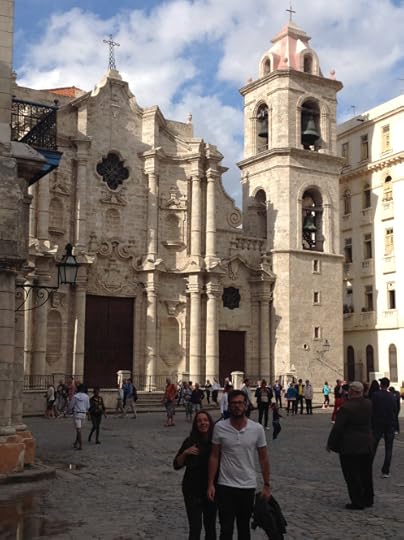
This is the cathedral. I didn’t get a pic of the fortune tellers because I did not want to be rude.
I was glad to get out from under my creepy feeling at El Bosque and go to lunch at Il Aljibe Paladar, a beautiful open-air restaurant famous for its grilled chicken. I had had chicken the night before, but I could not pass up the primo dish of the restaurant. It was, indeed, very good, and so were the black beans and rice that are served in every single restaurant at every single meal except for breakfast. We also had the obligatory boiled yucca, which is about as tasteless as it sounds, and plates of papaya, pineapple, and chopped cabbage. We were beginning to learn that even though Cuban farmers grow an astonishing array of fruits and vegetables, only a limited few make their way to the plates of tourists who eat at the restaurants. We never did figure out why.
After lunch we went back into Havana to El Callejon de Hamel, (Hamel alley), a narrow alleyway pulsing with visual and performance art dedicated to the African culture that is so important in Cuban life. The buildings lining the alley have been completely covered in paintings by the internationally renowned artist Salvador Gonzalez Escalona, who we had the pleasure of meeting. He is a very quiet, serious man, so quiet, in fact, that I did not hear a single word from him. He stood by quietly while a man dressed in what looked like very dressy, very colorful pajamas informed us about Escalona’s work, speaking as confidently and quickly as a traveling medicine show hawker. The man, who I figured was Escalona’s handler, ushered us through a frenzy of music, color, drumbeats, and twirling dancers, down into a cellar-like room, the walls of which were completely covered in paintings by Escalona.
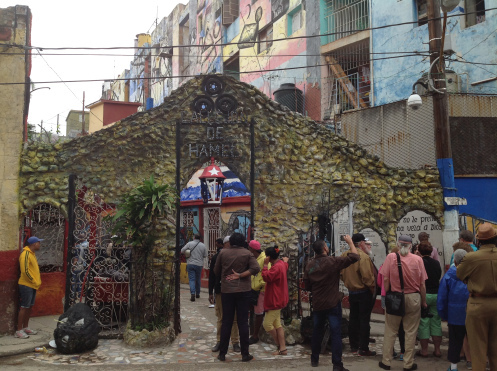
He shut the door behind us, lit some cloyingly sweet incense that immediately filled every corner of the room, stood in front of the door, and started talking. The room was so small we were all packed in tightly. Trying to take shallow breaths, looking around at the paintings of skulls, weird faces, totems, and strange animals, I immediately began to feel a little anxious, especially when I noticed that Mike had disappeared. He had escaped even before the door had closed, and I wondered what kind of trouble he might be getting into out amid the writhing dancers and the drumbeats. Suddenly, I came to the horrible conclusion that I am far too white, too Western-centric to appropriately appreciate this important artist, this culturally important place, and I shouldered my way out of there in a suffocating panic, abandoning my companions to another thirty minutes with the loquacious guide, the macabre paintings, the closed room full of overpowering, sweet incense.
Interestingly, my companions had diverse reactions to the event. One of the African American women in our group had the same alarming reaction that I did and escaped as quickly as she could, as did my friend who had been a missionary in Haiti for 30 years and had had enough exposure to Voodoo to last him a lifetime. Nearly everyone else calmly enjoyed the educational merit of the afternoon. Some of the lily-white members liked the ambience and paintings enough to purchase one. It just goes to show that everybody is different.
We moved on to the old section of the city and met a restoration architect who gave us an eye-opening tour of the beautiful old buildings for which Havana is famous. There is a frenzied effort to restore the old city, but the buildings are in such bad repair from years of neglect that most of them are uninhabitable. Havana is losing an average of two a day—they are literally falling down. We learned that even though the buildings are dangerous, dark, and condemned, one-half of Havana’s population still lives in them. There is no electricity or plumbing, the roofs are caving in, the balconies are falling off, but still, people live there. The government is trying to relocate people to other, safer housing, but there are yet not enough places to house them all. There is just a desperate scramble to try to stabilize things as quickly as possible.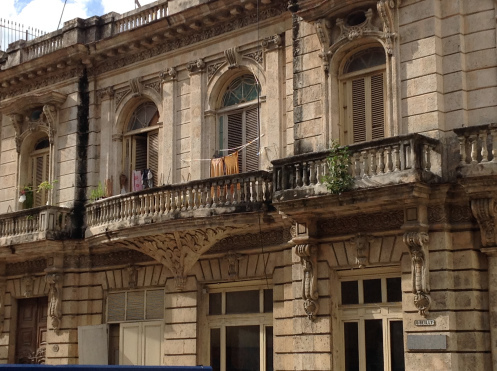

We hope these balconies will be repaired before they completely fall down
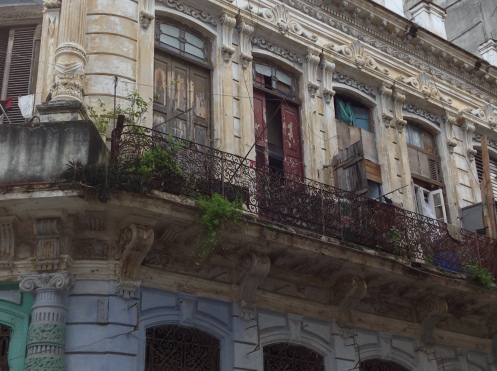
It’s falling apart, but several families live here
And yet, despite the urgency, things are moving excruciatingly slowly. It takes years for the government to restore a single building. Some buildings have been bought by private investors and refurbished for business use, and even though it is difficult to get the permits to do this, once things get over the government-imposed hurdles, the restoration or renovation happens quickly. One gorgeous building in Havana’s old square has been under construction by the government for 10 years. Our guide told us that some Americans are begging to get their hands on it, promising that they can completely finish it in two years. I am hopeful that some American historical preservationists will come riding in on their white horses one day soon and wave some American greenbacks around until they have done their magic.

This building has been under construction for 10 years. American developers say they can get it fully refurbished and occupied in 2 years.
It was incredibly frustrating to see these gorgeous buildings falling apart. Literally, stones fell off as we walked by them, but Castro’s government seems incapable of doing what it takes to preserve and restore them. Yet, we also have to be thankful for the Revolution even in this instance, for if it had not occurred, only a fraction of these grand old ladies would even be standing. In the 1950s, Batista’s government decided to modernize the city, and they began tearing down some of the most beautiful structures in town in order to put up hideous concrete, supposedly mid-century modern style buildings that actually had no style at all. In one section of town, we saw a model of a beautiful 400-year-old monastery that had been demolished to make room for such a pitiful excuse of a building. Batista had plans to systematically “modernize” the entire city, but fortunately, the Revolution came along and stopped the progress. Once again, we have to murmur “Viva la Revolution,” even as we dodge falling bricks.
By the time supper rolled around, we were getting pretty tired from our activity-packed day. It was a relief to sit on the back terrace of the hotel, drink mojitos, and order dinner from the bar. This also was an eye-opening experience. I frequently eat at Old Havana restaurant on Main Street in downtown Durham, NC, and I love the “authentic,” “classic” Cuban sandwiches served there. The “Santiago” is my favorite. It is a slab of smoked pork on “authentic” Cuban bread, slathered with mustard, drizzled with mojo sauce, smashed flat and grilled, and served up with a dill pickle and fried plantains. Yum.
This evening in Havana, Cuba, at the venerable old Hotel Nacional, I discovered that the truly “authentic” Cuban sandwich consists of a slab of pork stuffed inside a dry roll. Period. Real Cubans do not have the luxury of imported mustard, mojo sauce, and kosher dill pickles. There is no such thing as “authentic” Cuban bread, as so many Cuban Americans claim. We got bread at every restaurant we ate, and it all was slightly different. This notion of “authentic,” is an affectation contrived by Cubans who moved to Miami and began experimenting with the exotic ingredients afforded by an affluent culture. What we know as “classic” Cuban fare has been entirely invented by American-Cubans and does not exist in Cuba. So get off your high horse, Cuban-Americans, and quit saying that Miami is the place to get authentic Cuban food. You just made that up.
It was still cold and rainy, so after supper, Mike and I decided we would rather stay in and watch the Panthers play in the Super Bowl than join the rest of the group at the reenactment of the cannon battles at the Morro-Cabana fort on a nearby hill. I have to say, watching the Panthers lose in Spanish was just as disappointing as it would have been in English, but we did not regret our decision to stay in and go to bed early. I hear that the cannons were loud, the night was chilly, and the rain was wet.
I hope you are enjoying my recollections of Cuba and you will stay tuned for Day 3. I’ll get around to it in the next few days.


February 19, 2016
How We Feasted in Cuba
How We Feasted in Cuba
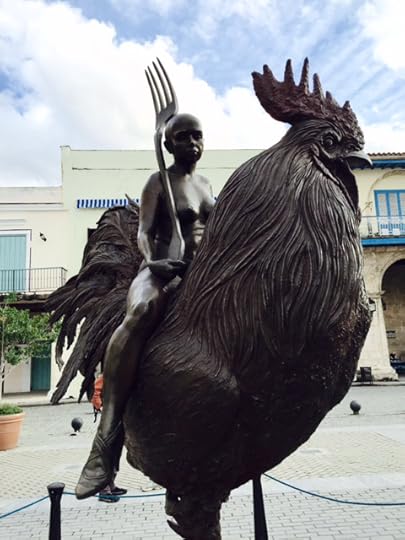
The minute Mike and I heard that relationships were thawing enough for US citizens to visit Cuba, we wistfully began wishing we could go “before it gets ruined.” Not long after that, our friend Elizabeth Turnbull announced that she and her Cuban husband Roberto Copa Matos, who own the Cuban restaurant, Old Havana, in Durham, NC were planning a culinary tour of this fascinating country. It did not take much to convince us to go, even though it means I will have to continue to drive my rusty, rattling, 1996 Ford pickup truck another year or two. Who cares about having a stylish car when you get the chance to have a little salsa infused into your soul?
We went, we ate, we threw up what we ate, we saw the sights, we missed a few sights, we stayed in glorious hotels and in sweet Cuban homes. We swam in the ocean and in crystal cave pools. We drove ourselves across rutted roads awash with mud and up a breathtaking river lined with Royal palm trees and cave-studded mountains. We danced on a rooftop high above the Havana cityscape as the sun blazed its last dying rays of the day. We met fascinating, kind people, some of whom we could not, because of the language barrier, exchange a single thought except how happy we were to have met them and how much we hoped to see them again. And now we are back in the good old USA. As I settle back into home and the comfort of my own bed, I’m taking the time to process the experience a day at a time. Join me! I don’t think you will be disappointed in reliving these wonderful days with me.
Day 1
Getting to Cuba is not easy. I would say impossible to do it on your own, so I am glad we left all the arrangements to the pros. You can’t go as a tourist just yet, but you can finagle your way if you are part of a missions or educational group. We went on something called a “people to people tour,” a “friendship” tour, so to speak, where we met with many Cuban citizens, enjoyed meaningful conversation, and generally worked on cultivating personal relationships. Think visiting people’s homes, meeting artists and musicians, touring farms, getting to know the farmers, and then meeting the chefs who prepare the produce from the farm just visited. And eating. Lots of eating. LOTS of eating. Don’t go on a tour called “Feast on Cuba,” led by a chef unless you are open to gaining a pound or 20.
We left from Tampa because, as we have heard, Miami is a nearly impossible departure point for Havana. It takes nearly all day to get to the tiny island nation just 90 miles southeast of Miami because of all the submitting of passports and visas, hurrying up and waiting that have to take place. After the short flight to Havana, we stepped out into bright sunshine, walked down the steps onto the tarmac, and made our way to a tired terminal building to wait in yet another line to be cleared through customs.
If you go, do not expect a lot of smiles from the officials at the Havana airport. You are entering a Socialist country, and they take their laws seriously. They scrutinize your passport, and your face. They tell you to take off your hat and stare at the camera. “Don’t smile,” they say, and when you get tickled with suppressed hysteria after all the tension of waiting, they stare at you until you get your giggles under control before they snap your picture and release you into an airy building where beautiful spotted Labradors run around, dragging their leashes, sniffing here and there. Do not pick up their leashes in the mistaken assumption that the dogs are lost and walk around with them, trying to find their owners. You will be reprimanded (I told Mike to leave them alone, but he was sure somebody needed to take care of them).
If you are part of an elite group, as somehow we were, you get to go to the VIP lounge where you will be treated to some interesting pastries and all the liquor you could possibly want while you wait for your luggage to be cleared through customs and your visas to be examined one last time. (For the sake of international relations and the health of our children, do not share information about this little perk to college students in search of a Spring Break destination)
There is no question that you will have to use the bathroom while you are waiting unless you have a bladder the size of a small city cistern and you have been smart enough to pee before disembarking the plane. Be sure you have followed the advice of your tour director and have secreted your own stash of toilet paper in your purse. Also, it is a good idea to have prepared your thigh muscles for the delicate art of hovering over the toilet rather than sitting. Toilet seats apparently are illegal in Cuba, for they have universally disappeared. If your toilet flushes, it is a lucky day. Almost as lucky is if you have a bucket and a functioning sink so you can fill it up and do your own flushing if the toilet mechanism has rusted out. Not so lucky is when you do not have running water in the sink. We were partly lucky in the VIP lounge. The toilet flushed but the sink did not have water to wash our hands. Sani wipes become a girl’s best friend.
After we were given the all clear, we wobbily gathered our belongings and headed for the government-owned luxury bus that was to be our mode of transportation for the trip, and we made our way to the Hotel Nacional, the government-owned luxury hotel that was to be home for 5 nights.
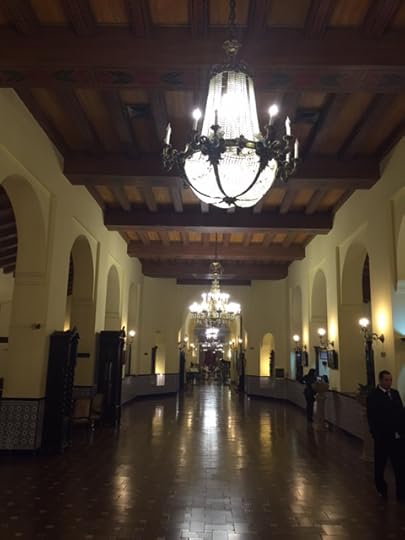
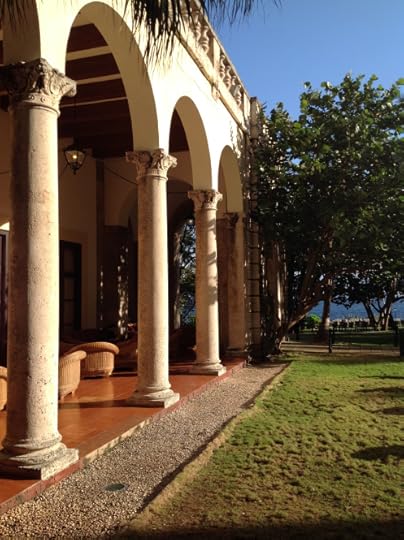
Back terrace of the Hotel Nacional
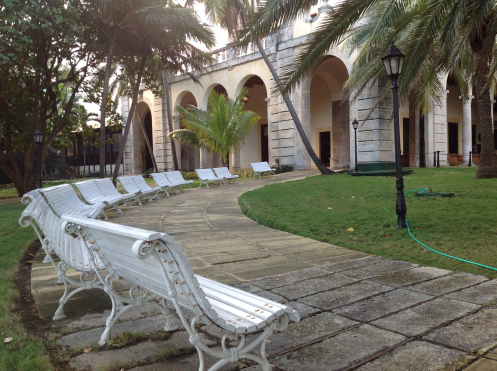
If you saw The Godfather, you may have heard of the Hotel Nacional. It was the grandest hotel in Cuba during the heyday of glamorous vice when the Mafia ruled the island. It sits on the shores of the Atlantic, facing north, on a promontory that has been heavily armed for the last century and a half. On the grounds are several large cannons, relics of the Spanish-American War, pointing toward the United States. Also on the grounds is a labyrinth of tunnels built in a prior century but reinforced and roofed over during the Cuban missile crisis (the Cubans call it the “Crisis of October, when the Imperialist Americans threatened the safety of the nation”). Like us in 1962, Cubans apparently believed that a little bit of concrete can protect you from a nuclear attack. I can’t help but wonder if they also taught their children how to cower under their desks in the event of a bomb landing on their schools. Looking at the museum there in one of the bunkers, which told the story of the missile crisis, I was more terrified than ever at what nearly happened in those dark days when Kennedy and Castro rattled their swords at one another.

Warfare used to be simpler
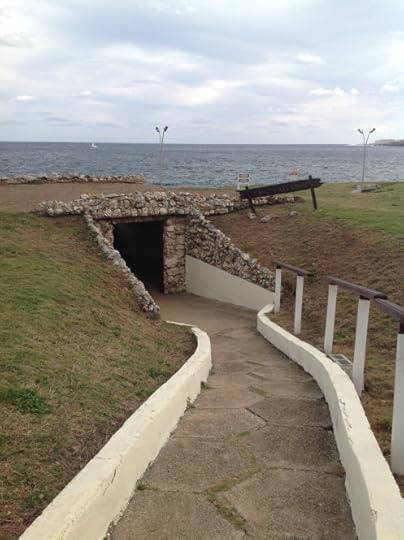 Bunker where people expected to be safe during Nuclear war with the US?
Bunker where people expected to be safe during Nuclear war with the US?
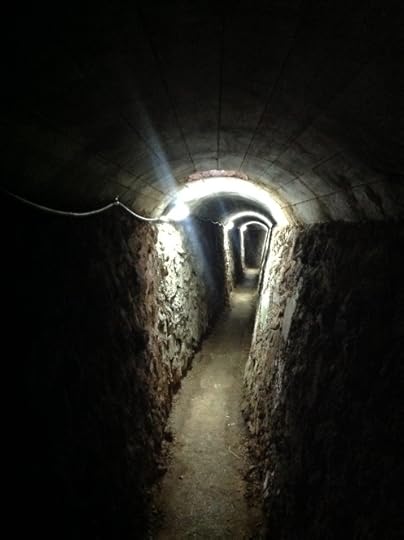
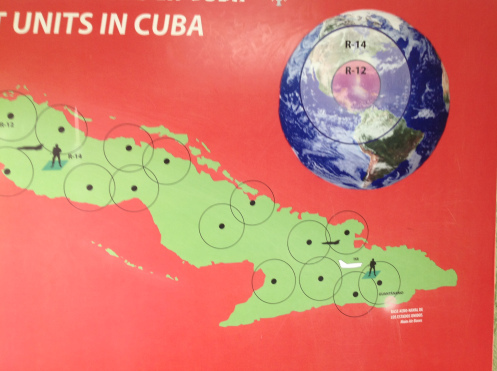
How scary is this?
But I am getting ahead. The Hotel Nacional was built long before the Cuban missile crisis. It was built long before Fidel Castro and Che Guevara took a hard look at what was happening to the people of Latin America and decided something had to be done. It was, in fact, opened in 1930, built by Americans for American tourists to come and behave badly with impunity. If you think Las Vegas is a den of iniquity, you should have seen Cuba in the 30s, 40s, and 50s. People of means—and I mean great means–flocked here to enjoy the casinos, the shows, the drugs, prostitutes, music, and all the other pleasures and vices this lovely island hosted. Early on, they came to escape the dreariness of America afforded by the Depression and Prohibition, and then, once the place had gained notoriety, it became the hangout for rich and famous. Paris Hilton’s grandfather once owned the National Hotel. Everybody in politics or popular culture who was anybody came to the Hotel Nacional at least once.
While the Mafia and its American clients were having a ball at the Hotel, Cubans were not allowed in, except as service providers. Blacks were not allowed, either, although an exception was made for Nat King Cole, who showed his appreciation by giving marvelous concerts. Slavery was abolished in 1886, but the mentality that people of color existed strictly to make white lives easier remained for long after. Oh, it was the place to be for the wealthy, the privileged, the unprincipled, and the lily white!
The Hotel Nacional reflected all of Cuba, and its story marks the history of the country. Like the hotel, very little of the whole country existed for the benefit of Cubans. Most of it was controlled by Americans and huge American corporations. Because prohibition and other pesky anti-vice and anti-monopoly laws back in the States made greed more difficult, the Mafia also found it a safe haven. The CIA had no problems with the Mafia having such control, because it wanted to keep this island neighbor an American satellite. Fulgencio Batista, who started out as the elected president of Cuba, happily climbed into bed with the Mafia for just a tiny share of the take, and he also enjoyed the protection of the CIA, even after he suspended Cuba’s constitution and made himself dictator. He did not give the term “dictator” any positive connotations.
You can guess what happened. Some Americans got filthy rich. The US government bolstered Batista in order to maintain control over the political landscape. People in power in the US government enjoyed fantastic perks and unlimited license in Cuba. For example, according to award winning historian Enrique Cirules in his book, The Mafia in Havana, the Dulles brothers single handedly dismantled the efficient and cheap trolley system in the city just because it competed with the bus line they happened to own. By the way, one brother was the head of the CIA, the other was Secretary of State. Such shenannagins were easy when the place exists merely for our pleasure, the dictator is too busy amassing millions for himself, and the people don’t matter.
Eventually, the inevitable revolution happened. Batista and his corrupt, brutal government was ousted, the Americans left, the wealthy Cubans who had backed Batista fled in a panic. The Hotel Nacional served as a backdrop for the drama of the time. It was the birthplace of the “26th of July Movement” in 1953, when Castro began preaching revolution. His first attempt to overthrow Batista ended in disaster, with Castro being imprisoned for a year, but the ideas that emerged in those hotel rooms solidified Revolutionary sentiment in the country. On January 1, 1959, at the triumph of the Revolution, the hotel staff took over as Castro and the new government of the Revolution nationalized everything from plantations to factories to hotels that had been owned by the wealthy. The Mafia was driven out. It is a bit of an exaggeration to say that anyone remotely connected with Batista, or anyone with too much wealth who was foolish enough to remain in the country was summarily dragged out into the town squares and shot, but it is not much of one. The people had thrown off the yolk of American Imperialism but had succumbed to the iron fist of another dictator.
From my scant history knowledge, I understand that socialism in Cuba was initially not a given. In 1959, immediately after the Revolution, Castro made overtures of friendship to the US in the hopes of recognition, aid and support. Eisenhower refused to even meet with him, and instead imposed an economic embargo, forcing Castro to turn elsewhere for aid. At first, the Soviets did not want to meet with him, either, calling him a representative of the “haute bourgeoisie,” suspected of working for the CIA. Later, however, Khrushchev embraced him, sent food to the starving people, and then began sending more than economic and humanitarian aid. Weapons crossed the Atlantic. In 1961, it was becoming apparent that the situation was getting too uncomfortable, so President Kennedy agreed to help a group of expatriated Cubans launch an invasion to overthrow the fledgling government of the Revolution. However, according to most accounts, at the last minute, he discovered that Russia had placed nuclear weapons all over the island, and they were not afraid to use them in the event of a US invasion. Kennedy called off the American involvement after the Cuban expats had set sail, failing to inform them that they were on their own, and somehow the Castro government was notified of the impending invasion. The hapless invaders were met by hostile fire as they landed at the Bay of Pigs. The rest, as they say, is history. Right after that, Castro announced that the Cuban political system would embrace Soviet style Socialism. Free enterprise, freedom of thought, and Christianity were banned. Christians caught practicing their faith were dragged before the firing squads. Christmas was abolished, making Fidel the ultimate Grinch. We suffered through the Cuban missile crisis, and the people of Cuba suffered through one of the most repressive regimes of the 20th century.
That’s just a little history represented by the grand old hotel that we entered the first day of our visit to Cuba. No wonder we found the place intoxicating. And we still had time to explore Havana!
Off we went before dinner to check out the city. Havana architecture is diverse, and it is grand, and it is sad. It is like a regal old lady who has fallen into poverty but has refused to give up her jewels. She still wears her tiara, her rings, and her pearls, but she is covered in grime. Her teeth are falling out, and her poor dress has disintegrated into a tattered rag.
I’ll talk more about the architecture in my next post, “Day 2,” but I know you are interested in the old cars, so I will take a moment to slake your curiosity: Yes, they are everywhere! Grand old 1957 Chevys, huge Buicks, Fords the size of boats, with swaths of chrome, fins and stripes, and loose suspensions, in every delightful, intense color imaginable. Most of them are in terrible shape, despite the loving care people have poured into them. Cracked windows are repaired with duct tape. Radios are missing, leather interiors are in shreds, rust worms its way over the chrome. But they run. They belch black smoke, they rattle, and they sway, but they run, the horns certainly work, and they look marvelous! You can’t help but look at them, smile, and say, “Viva la Revolution!” for a tiny moment as you feast your eyes and ears on all the color and noise.
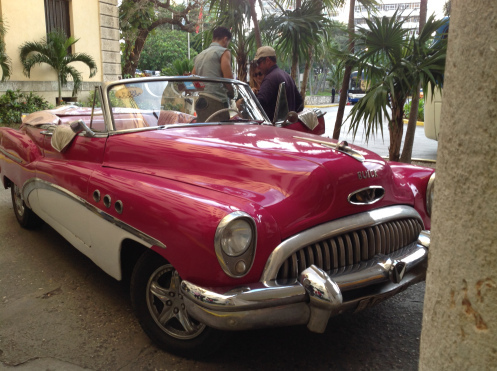
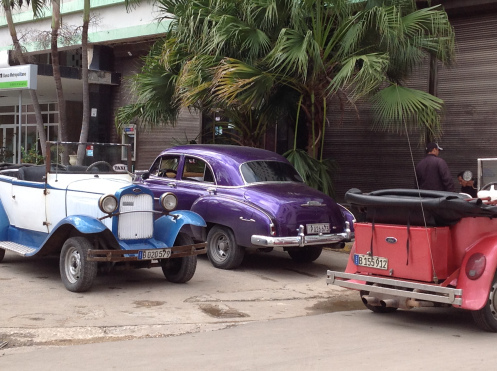
Our first diner in Havana was fabulous. The restaurant our hosts chose for us, La Casa, is a part of a new economic loosening experiments that is giving Cuba new life. After the collapse of the Soviet Union in 1991, aid to Cuba dried up, and the US embargo helped to make the Cuban people suffer a time of terrible hardship. They called it the “Special Time,” and it meant a time of near starvation. Our host, Roberto Copa Matos, came (escaped) to the United States some 15 years ago, so he has a good grasp of how hard life was then. He had one pair of shoes, discarded army boots with most of the eyelets missing so he could not really lace them up. He was literally hungry all the time–some days he did not eat at all. A university student for part of that time, he lived on the 17th floor of a student apartment building, and the elevator did not work. You get the picture. Life was really, really hard.
In the last few years, in an attempt to bring back some stability in the economy, Castro has allowed the introduction of a few private enterprises. They are, of course, government controlled and heavily taxed, but they are bright spots on the Cuban economic, cultural, and culinary landscapes. La Casa, our restaurant the first evening was the result of such a business. And dinner was fabulous! The building had been refurbished. We were treated to a performance by musicians who had played in some of the American clubs before the revolution. I am allergic to seafood and fish, so my diet is limited, but I did not suffer for the fact that I could not eat the lobster or fish that everyone else raved about. The chicken tasted like chicken tasted when, as a child, I visited my country relatives houses for Sunday dinner. It was, in short, the perfect introduction to our Feast on Cuba tour.
Day 1 was an adventure, a pleasure, a resounding success. Stay tuned. Over the next day or so I will return with an account of our continued feasting in Havana on Day 2
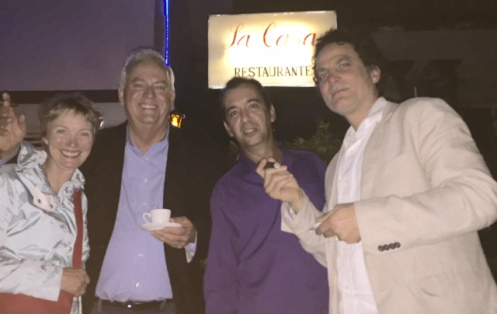
With our host, Roberto Copa Matos (far right) and one of our new Cuban friends


January 21, 2016
The Good Die Young
After three years of keeping chickens, I am forced to admit that the nature of most roosters is to be a jerk, although if you are very lucky, one may pass through now and then who has a very rare gentlemanly gene. Our first gentleman was Mr. Darcy, an elegant Marans who lived up to his name admirably. He was smallish, with insignificant comb and tail, sturdy, and solid black. In other words, not much to crow about in the looks department. The dominant roo at the time was a cocky (I learned early where the term came from) Americauna who first introduced us to the fact that roosters are the worst of sex-offenders.
We named him Dandy because he was so beautiful, with a big, red comb, white mane and a flamboyant copper tail. That was before we realized what a horrible thing he was, a bully who crowed loudly each morning, announcing that it was his right to rape and mutilate. Then he jumped on each of the girls with sadistic glee. He particularly liked to torment poor Bess, a tiny little lady who laid the most beautiful turquoise eggs. Once he realized that Bess was not as feisty as the others, he gave his sadistic bent full license, attacking her constantly until he had stripped her of most of her feathers and had pecked her head so hard that it split open, exposing her brain.
(Surprisingly, this did not seem to affect Bess as much as you might think. After we isolated her and nursed her back to health, she did just fine. Eventually, her head healed over, her feathers grew back thick and full, and she developed a strategy to stay out of Dandy’s way by spending most of her days roosting high up on a tiny ledge under the eaves where Dandy could not go. And she continued to faithfully lay those beautiful turquoise eggs.)
Then Mr. Darcy appeared on the scene. He was a true gentleman, always kind to the hens, and they soon learned that he would protect them from Dandy. Whenever Dandy made evil advances toward any of the ladies, she would run to Mr. Darcy, who placed himself between her and Dandy, raised his hackles, and said, “Back off, Dude!” It was a pleasure to watch him playing the role of protector.
Sadly, Darcy did not last long. A fox got into the henhouse by climbing the fence, then chewing his way through the chicken wire. In my dream that night, I heard crowing in the wee hours, and woke enough to tell myself that there is no way I could hear a rooster crowing from that far away. It is true. I have never heard crowing from inside the house before or since, even though we have a number of very loud roosters who stage crowing contests several times a day. I have to suppose that my “hearing” it was just a telepathic response to the trouble. How I wish I had listened to it!
The next morning, Mr. Darcy was gone, and his blood was smeared all over the inside of the door. Dandy was untouched, as were all the hens. Clearly, our brave, gallant, knight had died protecting his ladies from the fox. We mourned him then, and we still do.
Right after Darcy died, we incubated all the eggs, hoping that we might get one or two of his offspring. Imagine our delight when every single baby turned out solid black, the spitting image of Mr. Darcy! We were so pleased that when Dandy eventually died, we did not mourn him at all because we had new roos that we hoped would take after their daddy.
They did not. Of the two cockerels in the group, the dominant one we named Dandy Two, because he grew into a gloriously beautiful, prancing cock. The lesser one we named Sidekick. Dandy Two turned out to be a pretty good adult cock, somewhat sane and protective, but not the shining knight that Mr. Darcy had been. Sidekick, however, had killer instincts, not only going after the hens with a predatory rage, but also occasionally turning his meanness on the rest of us. Every once in a while he would sidle up, pretending to not be looking in our direction, and then suddenly he would turn and fly at us, claws out and mouth open. We renamed him LeRoy Brown because he was the baddest thing in the whole damn town.
LeRoy Brown did not last long after he started his psychopathic rages. At first, we treated him better than he deserved. He could not hurt us through boots and jeans, so we generally just swatted him off him when he attacked, but it was another matter when babies became involved. The last straw came the day he attacked little Wells, my grandson. He sidled up while I was bending over the food bin, and the next thing I knew, he was in the air, flapping his wings, claws extended toward Wells, and then I was kicking the stuffings out of him before I was even aware of what had happened. That evening, Mike put a bullet in his brain, and LeRoy Brown became our introduction to home-grown coc au vin.
(An interesting side note to this story: The moment LeRoy Brown had been killed, one of the hens rushed over and kicked him. This really happened. He was one hated S.O.B.)
Now, Dandy Two is doing a fair job of roostering. He looks out for the flock, announces it when he finds a tasty morsel so the hens can come enjoy it, and generally keeps our newest crop of young roos in line. There is a gang of five young criminals who run around harassing and torturing the hens, and Dandy has his hands full beating them off. He, himself, however, is only partially civilized. He may keep the young roos at bay, but he is by no means a kind and gentle lover, nor is he brave. Whenever a chicken hawk hovers overhead, he squawks and crows, and then he heads for cover without a thought for the ladies.
Only one of the new group of young cockerels had a gentlemanly streak. I had named him Darcy Two because he had begun to be protective of the girls. He was not particularly beautiful: his tail was not the shimmery teal color of the others, his mane was short and drab, but his soul was angelic. The hens had learned to run to him whenever the gang of five came roving in their direction, and I looked forward to the day he would take Dandy Two’s place as Cock of the Coop. Dandy is beautiful, but I now know that roosters are dispensable. I had decided that if he became belligerent toward my new Darcy, I was all for putting him in the pot.
Tragically, a chicken hawk got Darcy this week, driving home the truth of the old adage that the good die young. Once again, the only kind and protective guy in the yard sacrificed himself so that the ladies might live. The first Mr. Darcy went up against a fox, and now Darcy Two has faced a hawk while everyone else ran to safety. The sad part of nature is that the bravest and best expose themselves to danger while the sly and sinister thrive in the corners. Our gang of five revels in evil, then runs for cover. The Dandies cry and cower in the henhouse whenever a shadow passes overhead. My sweet Darcies throw themselves at predators so the hens can survive. It does not seem fair, or fitting, and to me, it does not make any sense. Aren’t the bravest and best supposed to be the ones who live long and prosper? Isn’t that what Disney and every other great storyteller makes sure we understand?
In the Spring, we will hatch out another batch of chicks. Until they are a few weeks old, all of them will be fluffy, cuddly little darlings who nestle in the palms of my grandbabies’ hands. Then time will coax out their true natures. The pullets will grow into docile ladies, and the cockerels will transform into the world’s biggest jerks. I can only hope there will be a single sweetheart among them.


April 6, 2015
WHY YES, THOSE ARE DISPOSABLE DIAPERS HANGING ON THE LINE TO DRY. DO YOU SEE A PROBLEM WITH THAT?
I realize that the continuum from completely normal to slightly odd to definitely eccentric to mad as a hatter is as fluid as a drop of mercury on a seesaw. It’s all a matter of changing perspectives, as we find ourselves going from curious to immersed in something, and then going all the way to completely gaga.
My latest foray from the land of normal began with one of those life hack videos I saw on Facebook about dismantling disposable diapers and adding them to potting soil. The absorbent center contains cotton, wood pulp and sodium polyacrylate crystals, which hold many times their weight in water, and then slowly release it as the diaper dries out. If you add the innards of these diapers to your potted plants, (1) you can’t really overwater because the crystals soak up the excess water so it doesn’t stand around rotting the roots of your plants, and (2) when the soil starts to dry out, the roots can harvest all that stored water in the crystals.
Wow! What a great idea! Especially when you are using small containers or keep your potted plant out in the sun and you forget to water on schedule! When I saw this video, I immediately remembered that I had seen several boxes of adult diapers at the Goodwill the week before, so I rushed out to buy some.
Wow, again! Although those things are HUGE! (that’s good. More for my baby plants), they are more expensive than I thought they would be (that’s bad). Even at the Goodwill, they were $10 a box. But they worked pretty well. Mixing the stuffing with potting soil did stretch the soil, and I could see how those little crystals soaked up water. Excited, I thought about going out to get the rest of the boxes languishing on the shelves of the Goodwill, but then realized, “Hey, we have a baby in the house. . .”
Which led to, “I wonder if urine is toxic to plants,” which led to my good friend Google, which led to the discovery that, Surprise! HUMAN URINE IS AN EXCELLENT FERTELIZER!! Ta da! Zip me on down the seesaw to the Mad as a Hatter category! Right after I read the article where a Swedish scientist has restructured his whole toilet system to capture all the urine produced by his family to fertilize his garden! Actually, I’m not even close to the “Hatter” Category. That scientist is. He claims his beets are the sweetest in town. (Thanks to the narrow-mindedness of Durham officials, I am saved from that irksome label).
This weekend, I came close, however, when I found myself in the greenhouse, ripping apart Wells’ wet diapers, tearing them into shreds, mixing them with potting soil, stuffing them into pots for my geraniums, and chortling with glee. “Free! Recycling! Reducing landfill waste!” I gloat. “Saving the environment! Organic!” (Yes, the diapers ARE organic, according to the label, but I am sort of suspicious that those sodium polyacrylate crystals might not qualify).
So now, I’m a just-this-side-of-the-edge convert, saving up wet diapers for use in my potting shed. Parents and Grandparents, if you are the squeamish type who doesn’t feel “normal” ripping up pee-soaked diapers to put in your flowerpots, bring them over to me. I’ll just hang them on the line to dry and store them until I’m ready to start my new seedlings. Who knew baby piss could save the environment and grow sweeter sweet potatoes and peppier peppers? Now we all do. I hope to see you soon just down the lane from Normal.


January 17, 2015
Sometimes, Growing Old Isn’t So Bad
The first time Eleanor flew, she was as surprised as anyone.
She had been standing at the western edge of the Copper Canyon beside her sister, Martha, when suddenly Ruth Ann started making retching noises behind them. “Montezuma’s revenge,” began Eleanor, but before the words were out of her mouth, Martha turned to look at Ruth Ann and bumped Eleanor with her backpack. Off Eleanor fell, into the vast, yellow sunlight.
Panic and a strong instinct for survival set Eleanor to flailing, her skinny arms and pudgy legs windmilling through space like a swimmer with sharks behind her. Part of her knew her exertions were useless, but she fought anyway, churning the air with a vigor she hadn’t shown since she had been twelve years old and determined to win the sack race at her 6th grade field day. After several moments, Eleanor realized that something unusual was happening: the ground seemed to be getting further away. She was no expert, but was pretty sure that the ground was supposed to rush up at you as you plummeted toward it. But it definitely looked farther way, and as she flapped her arms harder, it fell farther away still. Shocked, she fell still, and the falling sensation hit her—she tumbled down through space, the air rushing by her so fast that she could hardly breathe. And when she looked again, the ground definitely was rushing up toward her with astonishing speed.
Panic set in again, prompting her to rotate her arms and kick her legs once more. To her surprise, she felt her body pause, then lift again, and she realized with a jolt that she was actually flying! It felt just like swimming, except that air was easier to navigate than water. There was no resistance, just a light buoyancy that made her flaccid, puny arms feel like powerful swimmer’s arms, and her cellulite-riddled thighs felt capable of some serious horsepower. She looked back from the place she had come. Back at the lip of the canyon, the other girls were mere specks, she could hardly make them out at all, particularly since she had lost her glasses shortly after she took off. Without even thinking about it, Eleanor did a neat turn and confidently began a smooth breaststroke through a fine cloud. All she did was kick her feet the tiniest little bit, and she straightened her course and sailed through the air with a grace he had never known in her 63 years.
She drew closer to the rim of the canyon until she was able to discern four of the girls standing agape, watching her. Martha lay behind them on the ground, obviously in a faint, but no one was tending to her. They were all staring at Eleanor as she swooped over their heads and flipped on her back, commanding the air currents as if she owned them.
After that day, Eleanor flew often, but she clearly was not the same sweet Eleanor that everyone had known. No, she became arrogant and proud, and lorded her newfound abilities over the others so much that eventually they got tired of hearing about her flights. They even began to ignore her when they actually saw her run through the grass and take off like a great gray heron, at once ungainly and graceful. She didn’t care. She could fly, and nobody but she knew what that felt like.

Deborah Hining's Blog
- Deborah Hining's profile
- 26 followers



